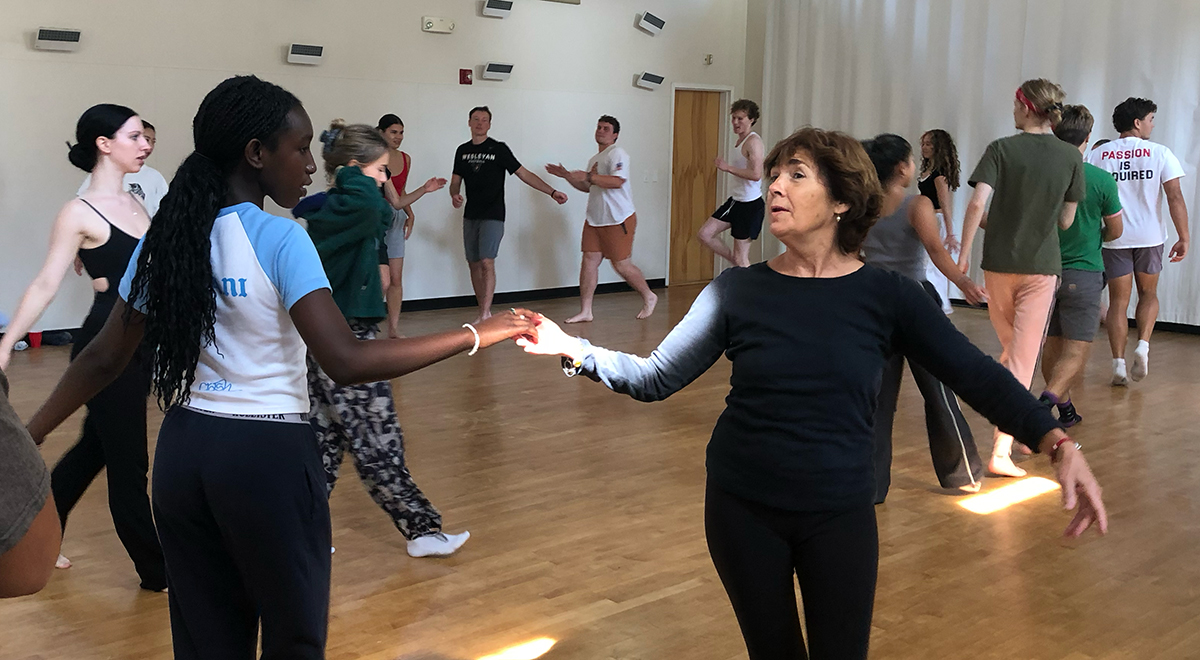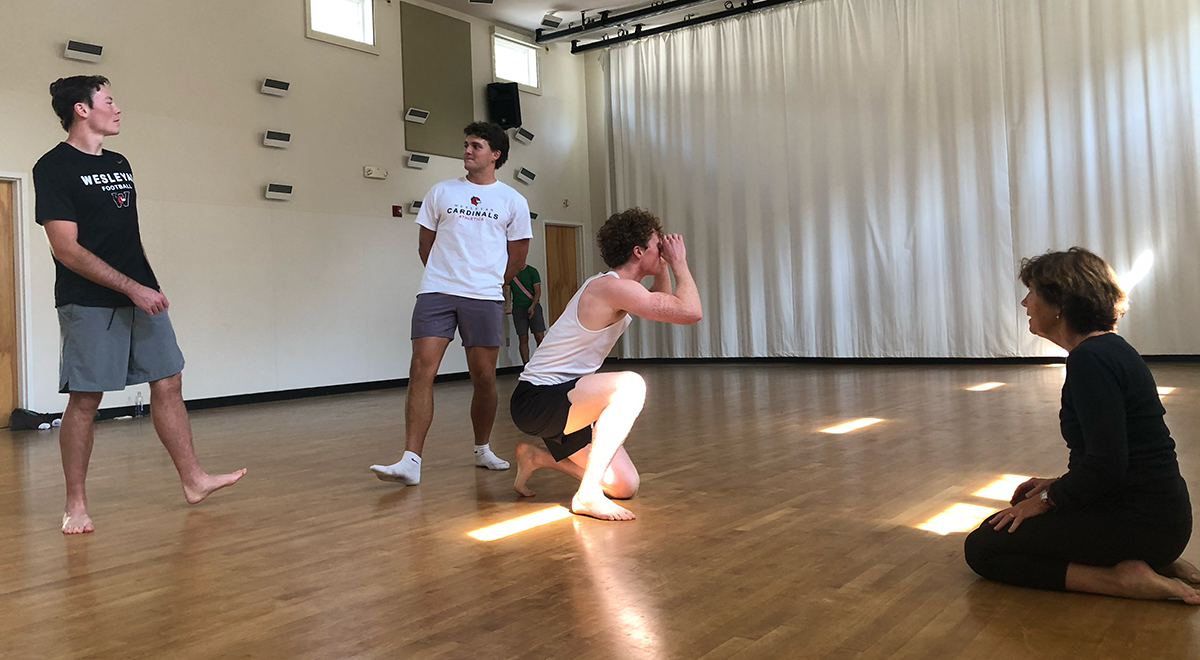Faculty Member Revives French Baroque Dance Style in New Choreography

Patricia Beaman didn’t always know that she could be successful as a professional dancer. But after four decades, she’s made her mark reviving a lesser-known form of art: French Baroque dance.
A University Professor of Dance at Wesleyan, Beaman has made a name for herself in the Baroque dance world, specializing in French dances from that era, which spans the years 1600 to 1750. In addition to dancing professionally for 40 years, she has also been teaching dance for more than three decades. “It’s nice to have that balance,” Beaman says of working in academia and on creative projects.
Commuting from New York to Middletown, she first started teaching Baroque dance, ballet technique, and dance history at the University as a visiting artist in 1991, then as an artist in residence in 1998. Between 2007 and 2009, Beaman created the solo Neo-Baroque work Goddess/Siren/Monster, which she performed at Wesleyan and toured to New York, Toronto, and Avignon, France. The latest work Beaman choreographed, the Neo-Baroque dance-drama The Jewel Thief, premieres Dec. 6 and 7, 2024 at Wesleyan’s Center for the Arts Theater.
Beaman describes Baroque dance as being about the turn of the wrist, intricate footwork, and the carriage of the body, with costuming dictating what the body can do. “You’re in a corset, you have a long dress on, right?” Beaman said. “Sort of mid-calf length. So you’re not going to have high legs, the arms aren’t going to go high…the arms are always rounded.”
Beaman said you cannot fully grasp Baroque dance without understanding the sociopolitical surroundings that created the dances of the era. “I’m kind of a nut when it comes to French kings,” Beaman laughs. “I know more about, you know, French monarchy than the American presidents. It’s just fascinating.”
Beaman is also the author of World Dance Cultures: From Ritual to Spectacle (Routledge Press, 2017, 2023).
Beaman’s Path to Baroque Dance
In 1984, Beaman debuted with the New York Baroque Dance Company in Gluck’s Orfeo ed Euridice at Marymount Manhattan Theater. “Everything is sort of as if you’re in a kinesthetic bubble,” Beaman said. “My ballet dancing got, actually, a lot more intricate and detail-oriented,” she said of her time with the company, touring the U.S., Mexico, Puerto Rico, and Europe. The Gluck work remains one of her favorite myths and pieces of music, and Beaman is an advisor to the company.
Born in Bronxville, New York, Beaman grew up with Baroque music. Her father, a tax lawyer for General Electric, loved the works of Bach and Handel. She started modern dance classes in seventh grade at a school founded by German immigrant Steffi Nossen. Beaman’s family moved to Brussels when she was going into 12th grade. “I was devastated,” Beaman said. “And then, I loved it.”
Her teachers said she could be a dancer, but she’d have to work very hard. “That was the first sort of inkling that, ‘wow! I could actually do this?,’ you know, for my life,” Beaman laughed. “As a contemporary dance performer, I never dreamt that I would eventually become involved with French 18th-century Baroque dance.”
In Europe, she focused on ballet, heading to Paris for her first year of college. After graduating with a Bachelor of Fine Arts from the University of Michigan Dance Department, she returned to New York. She saw the New York Baroque Dance Company was going to France and auditioned in 1983, getting cast as an understudy. “It was an education in this world,” Beaman said. “It was a whole new way of learning how to move, and so different from contemporary dance.”
Last year, Wesleyan’s John Spencer Camp Professor of Music Neely Bruce told Beaman he had written a ballet, based on Hitchcock’s 1955 thriller To Catch a Thief, that had never been choreographed, wondering if she would like to collaborate. “It doesn’t get any better than that in my head, because I love Hitchcock, and that film is just so wonderful,” Beaman said. “I love working with narrative, and so it’s been really fun writing the libretto and working so closely with Neely and his music.”
Bruce will conduct the performance of his score by an ensemble, including Piano Instructor Carolyn Halsted. Canadian company inDANCE—directed by Professor of Dance, Global South Asian Studies, and Feminist, Gender, and Sexuality Studies Hari Krishnan—will premiere his work ROWDIES IN LOVE during the same concert on Dec. 6 and 7.
Beaman worked on the text and choreography of The Jewel Thief during her sabbatical this past spring. “There’s lots of intrigue,” Beaman said. “There’s thugs and gangsters.”
She also has several creative concepts for the costumes. “The students are going to make their own masks for the ball, which is a highlight in the show,” Beaman said of the class she is teaching this fall, DANC 378 “Repertory and Performance.” “I can’t wait to get in the studio with my cast.”
Beaman said the design of the masks will be inspired by the look of author Truman Capote’s 1966 masquerade “Black and White Ball,” held at the Plaza Hotel. “At midnight, everybody took off their masks,” Beaman said. “Ostensibly, you didn’t know who people were.” The event was recently depicted during the second season of the FX television series Feud.
Beaman also has drawn inspiration from the silver, Modernist costume parties of the Bauhaus art school in Weimar, Germany during the 1920s, and from the letters of diarist Madame Sévigné to her daughter chronicling the lavish fêtes of King Louis XIV. “She would talk about what happened last night, what the women were wearing,” Beaman said. “And again, there was a black-and-white fad, where women would have either black underneath or white, and then either white or black opposite lace overlay. So I’m hoping I can bring in all of these sort of things as far as costuming goes.”

Some Wesleyan students in the work have taken ballet with her, along with four football players who have taken her course DANC 111 “Introduction to Dance.” “The athletes are phenomenal,” Beaman said. “They’re not quite sure what they’re going to be doing, but they’re always up front. They’re ready to go. And I just love that work ethic,” Beaman said of their hard work.
Beaman wants to build bridges between levels of ability, and between people that think that they don’t have anything in common. “They find out that they do,” Beaman said. “I just want to smash down those walls and get everybody dancing.”

